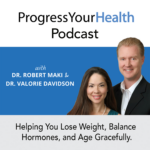

In this episode, we answer a reader question. This question is from Jen, responding to one of our articles. Jen’s question is important because hormone treatment can often come as a prescription. And it is important to understand our prescriptions and if they are actually going to be beneficial.
Jen’s question relates to her current BHRT prescription that her doctor has recently put her on. She has side effects from her medication. Plus she is not noticing the effectiveness that she was hoping.
Question From Jenn:
Hi, I stopped cycle four yrs ago- for four weeks now – I’m taking E2/E3/T 1/1/4 (1/4 gr applied morning and 1/4 gr applied at night). If I am receiving 1/2 gram a day, I am receiving .50 mg E2 and .50 mg E3 & 2 mg of Testosterone.
I am getting dull headaches at the back side of head 4 to 5 hrs before the 12 hours app time, but breast tenderness which I hate. I have asked my doc to up to 1.5/1.5 per gram still applying the same quantity (1/2 gram daily)- and request Testosterone in a separate compound. Meaning I will receive .75mg of each E2/E3 a day and hold off on Testosterone to see if headaches are lack of E for sure.
After reading your responses, I wish I would have suggested a different ratio. Perhaps leave the E2 at 1mg/gr. Or drop to .50 and increase the E3 to 2.5 -3.0 mg. E3 might help w/breast tenderness? I take oral 1 mg prog at night. Your thoughts? Is 0.50mg/gr E2 which equates to receiving .25 mg of E2 a day too low, I want the benefits of E2 -hair skin happy, but don’t want to feel fat and pregnant.
Thank you in advance for your response and your thoughts. Jenn
One thing we cannot stress enough is there is not a one-size-fits-all for BHRT dosing. Everyone is unique, and there are many aspects to developing an individualized BHRT plan. In our patient population, everyone’s BHRT is based on their personal and family history, health goals, symptoms, as well as lab data. We then keep continuous follow up with them, because the body is not static.
People’s BHRT doses will change over time, whether it is age, change in health goals, stressors, symptoms, etc. It is important to keep close follow up with the patient to ensure their hormone doses are accurate and working well in their lives. We really like Jenn’s message because her situation is common. She is on BHRT, but it is not quite working for her and alleviate her symptoms.
Also, Jen is experiencing side effects from her prescription dosages. She is getting headaches and breast tenderness which is typical because she is receiving an imbalance of the estrogen. I am assuming that she wrote in a typo and is actually taking 100mg of progesterone capsule at night. Jen’s breast tenderness is most likely coming from the estrogen in her hormone cream. We would recommend for someone in Jen’s case to have a biest 80:20 ratio. This is where there is 80% estriol to a 20% estradiol ratio. Higher levels of estradiol can cause breast tenderness.
The testosterone might be a little bit high compared to the Biest ratio. Usually, in a woman receiving BHRT for the first time, it is a good idea to start with the estradiol/estriol as an 80:20 ratio first. Then you add in the testosterone later after the estrogen has been balanced.
Also, Jen’s question is important because there are so many dosing options for BHRT and this can be confusing for the patient as well as the doctor. As you can see from Jen’s prescription, she is asking questions about her dosing and how much she is currently taking, versus what she thinks she should be taking and what the doctor could change it to and so forth.
There are so many different doses in BHRT for estrogen. The estriol and estradiol can come in any ratio. From 90% estriol to 10% estradiol to 80/20 to 50/50. And you can have straight estradiol only or estriol only.
Then there are the doses and how much to apply to the skin. You can apply ¼ gram to ½ gram to an entire gram of hormone cream, once to twice a day. It can be confusing as in Jen’s case that she is on Biest (estriol/estradiol) 2mg as a 50:50 ratio per gram. Meaning, that in one gram of cream there is 1.0mg of estriol and 1.0mg of estradiol. Like Jen mentioned she is taking ¼ gram morning and evening. That means that she is getting .25mg of estriol and .25mg of estradiol per application.
Estradiol can cause breast tenderness, and a lack of estriol can cause headaches. In her question, Jen wants to know if she could increase her cream to ½ gram twice a day. That would make each application, .5mg of estriol and .5mg of estradiol. Because the estradiol is increased, it would make her breast tenderness worse. But because her estriol is increased, it would help her headaches. Like mentioned above, everyone’s goals are different in BHRT. Some want to alleviate hot flashes and night sweats. Some want to work on insomnia and mood swing.
Others want weight loss, skin and hair issues or vaginal atrophy. Either way, BHRT is great for anti-aging, it just depends on the person’s goals. In Jen’s case, switching her to an 80:20 ratio of estriol to estradiol would be a great step for her headaches and breast tenderness.
Reducing the estradiol would help with the weight gain. Later add in the testosterone after she is feeling better. But making sure she always takes a good dose of progesterone. Because anytime a woman is taking estrogen she should also be taking progesterone.
This protects the breast tissue, balances any estrogen dominance and if she has a uterus, will protect from uterine cancer. If Jen continues to have breast tenderness raising her progesterone could be helpful. Or switching to a sustained release progesterone might be a good option.
The sustained release would stay in her system longer than an instant release. This might help balance the estrogen better to reduce or prevent her breast tenderness. Another option for breast tenderness is to take iodine.
Supplemental iodine can be helpful for breast tenderness. Although, iodine can affect the thyroid gland. If taking iodine supplements, it would be a good idea to check the thyroid levels just to ensure the iodine is not affecting the levels.
We want to thank Jen for reaching out and asking her BHRT question. Because her concerns can help others wondering about BHRT ratios, doses, and side effects.
If you have any questions, leave a comment below or you can send email to [email protected].
The post Can Biest Cause Headaches? | PYHP 051 appeared first on .
Discover the common and unfamiliar symptoms that you might be experiencing. Get access to cases of real women with hormonal conditions.

In this episode, we discuss a question from Janice, a podcast listener’s question regarding the benefits of estrogen therapy for heart health. There is much evidence to show that estrogen has cardiovascular protective benefits. We wanted to discuss how estrogen benefits heart health and can help reduce the risk of cardiovascular disease. Janice’s Question: Are […]
In this episode, we talk about the benefits of estrogen on bones. A listener’s question (Alison) inspired this episode. Alison asked if taking vaginal biest has the same heart and bone effects that other estrogens and estrogen therapies have. So, we wanted to expand on estrogen’s role in helping keep bones strong and healthy. In […]
In this episode, we talk about hormone treatments for perimenopause and menopause. There is a vast distinction between perimenopause and menopause when it comes to treatment options. We often see women who are being treated for menopause when they are genuinely not in menopause. Meet Linda: Linda is a listener who sent us a question […]
Recently, Catherine posted a question on our website about Biest cream, and we knew this could interest our listeners. Biest is a combination of estriol and estradiol, one of the most common forms of estrogen therapy used in bio-identical hormone replacement. There are many doses, ratios, options, and methods of using Biest, so we thought […]
Welcome to the Progress Your Health Podcast! This is a podcast that helps you learn about balancing hormones, especially during perimenopause and menopause. We love hearing from our listeners. If you have a question, please visit our website and click Ask the Doctor a question. Let’s read Brigitte’s question! I have been listening and learning […]
In this episode, we talk about the difference between perimenopause and menopause. Both Dr. Maki and I (Dr. Davidson) have worked with women in perimenopause and menopause since 2004 and sometimes get a bit myopic and technical when it comes to explaining the differences. The other day, a patient of Dr Maki’s asked the question, […]